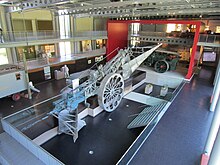Deep plowing
Deep plowing , as trenches (rigole of fr., D. E. Channel), formerly known as or Rajolen or Rejolen referred to is a measure for agricultural amelioration or peat cultivation . Here, the soil is deepened with a deep plow (also called Rigolpflug, Rajolpflug or Tiefgangpflug), i.e. H. according to DIN 1185 more than 60 cm deep, up to a maximum of about 2.5 meters deep, wrapped . The aim of deep plowing is to overturn the topsoil and subsoil , so that the soil profile results in an inclined alternating stratification of draining subsoil layers and water-storing humus topsoil, and / or the breaking up of water-impermeable layers of local stone in the subsoil.
Occasion and procedure
When cultivating heathland , the starting soil is usually a podzol . By deep plowing, the solidified stone in the subsoil, which prevents root penetration and leads to the formation of waterlogging , can be broken up. In addition, the leached topsoil is mixed with the raw humus layer , so that after nitrogen fertilization and liming to raise the pH value, which is usually too low, an agriculturally usable soil is created.
For the amelioration of parabrown earth and pseudoglyb soils , the clay enrichment horizon in the subsoil is broken up by deep plowing in order to prevent the formation of waterlogging and loosen the soil deeply.
In the peat cultivation is Anmoor , a low powerful mud or the residue of a ausgetorften Moores with the underlying mineral soil overturned. Raising the mineral soil improves the permeability , water capacity and rootability of the soil so that it can be used for agriculture.
The soils created by a one-time break in depth show a typical sequence of stripes of the paved horizons and are known as treposoles . With repeated breaks, a deeply homogeneous area is created. The resulting soil is a Rigosol .
Between 1938 and 1978, around 180,000 hectares of land in north-western Germany ( Lower Saxony , Schleswig-Holstein and North Rhine-Westphalia ) were made arable by deep plowing.
History and technology
Deep plowing has only been possible since the late 19th century , when the steam plow became available to drive machines with which the plowing depths possible with animal traction could be exceeded by around 200%.
Previously, the Dutch fen culture was rigged by hand with a spade . For one hectare of raised bog (at a working depth of one meter) a labor requirement of 8500 manpower hours (Akh) was necessary. With the steam plow this was reduced to 60 Akh / ha with the same working depth, in the motorized pull with caterpillar tractors to around 20 Akh / ha.
When deep plowing with the steam plow, the plow was pulled back and forth by means of ropes between two (or sometimes two pairs of) locomobiles , which were set up opposite one another on the edges of the field and were moved a little after each pass. If the output of the steam locomotive properties was initially around 100 hp at a lower working depth, four steam locomotives each with 500 hp each were eventually used due to the disproportionately increasing power requirement with increasing working depth. A deep plow set with four locomobiles required eleven workers, the maximum daily output was approx. 2 ha.
With the advent of powerful wheeled and caterpillar tractors from the second half of the 20th century, the rope plows pulled by steam locomotives were replaced by tractors moving on the land to be plowed, although even these sometimes require multiple traction. Even with multiple traction, the labor requirement is only three to five people. In addition to plows with their own chassis, mounted plows are also used.
With some soils there is a risk that an existing humus layer will be destroyed.
See also
literature
- R. Eggelsmann in: Journal for cultural technology and land consolidation 20 . Paul Parey, Berlin and Hamburg 1979, pages 99 to 112
Web links
Individual evidence
- ↑ Trench instead of digging. Retrieved May 22, 2013 .
- ^ Brockhaus Bilder-Conversations-Lexikon from 1839. Retrieved on May 21, 2013 .
- ↑ Annie Francé-Harrar : The last chance - for a future without need , new edition 2007, page 564


